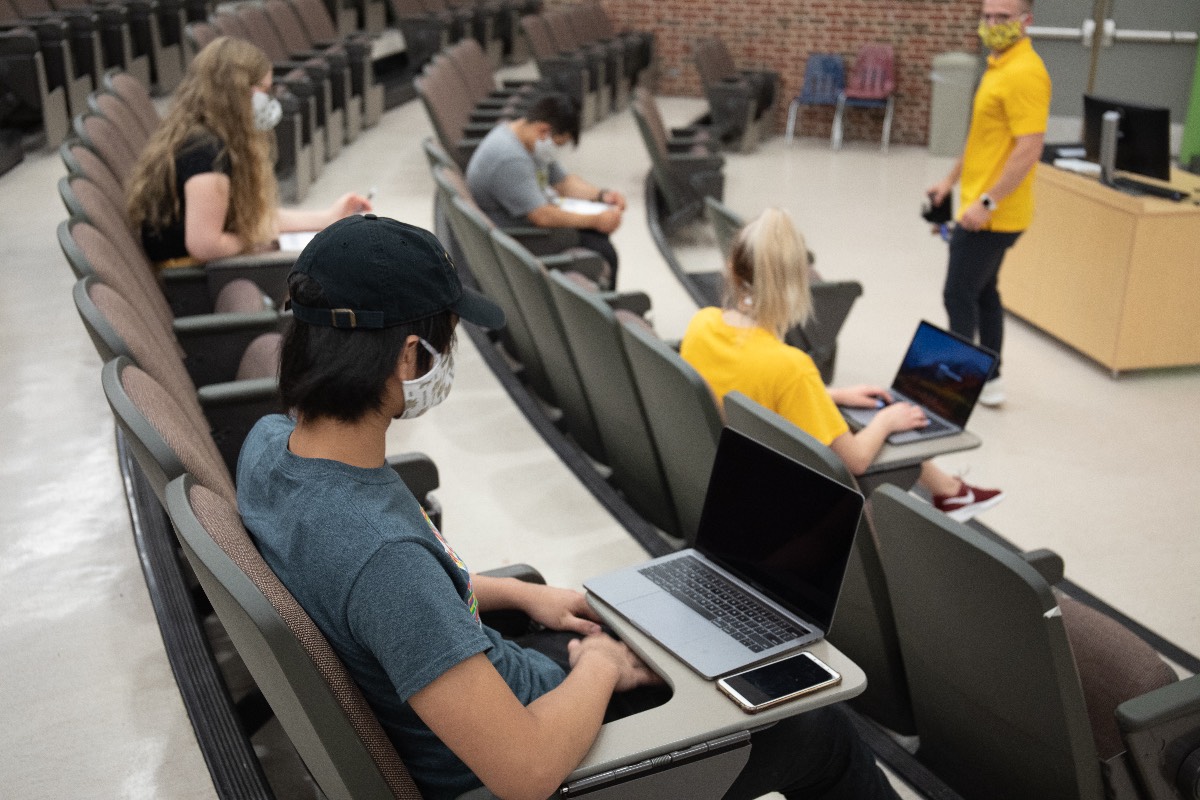Wichita State University Instructor Cindy Malcolm considers building a classroom community critical to her work in the College of Applied Studies.
Remote learning seemed an obstacle to that camaraderie among aspiring teachers who can benefit from collaboration and support as they prepare for their first job.
Building a community during a pandemic is different, but not impossible, she learned.
Wichita State’s Instructional Design and Access team helped Malcolm through the hectic turn to remote learning last spring and then helped her upgrade her classes over the summer. This semester, she added breakout rooms to her “Introduction to Teaching” on Zoom and found a way to bring people together through a computer.
IDA showed her how to add breakout rooms. “Speed friending” helped students get acquainted with one-minute sessions in the breakout rooms. They told stories about good teachers and good school experiences and discussed career goals.
“I tell my students that you always want to surround yourself with marigolds – they’re really supportive of other flowers,” Malcolm said. “I felt that whole group from IDA was marigold people – they were supportive. They really want you to succeed.”
IDA, part of Wichita State’s Media Resources Center (MRC), updated its standards for success over the past six months during the COVID-19 pandemic.
In February and March, the IDA team worked fast to lead the university’s move to remote learning. After that launch, it turned its focus to preparing for the fall.
Media Resources Center
“We were assuming there would a major online component and that we no longer would have the grace granted by the emergency of moving online at the last minute,” said John Jones, MRC director. “Fall’s online instruction would have to be high quality, very responsible, very well-done. It would have to meet the standards that we try and set here and be online in a way it had never been online before.”
That meant training for faculty and using the summer months to prepare. IDA took its one-day Academic Resources Conference and turned it into a week of training, via Zoom, in June and again in August before classes started. Another week is scheduled in January to prepare spring classes.
The June and August conferences attracted more than 100 participants for more than 550 hours of training. More than 50 trainers from 20 Wichita State offices (and two vendor trainers) joined the workshops, which offered 88 training topics over the summer.
“It’s a story of faculty and their hunger to learn and their intense desire to be successful in the transition,” said Carolyn Speer, IDA manager. “We were successful with our initial pivot in March. Because of that success, it became really obvious to everybody they were going to need training, because they had already proven they could do it. Now they had to get better.”
Over the summer, IDA worked with faculty members interested in exploring and expanding the boundaries of remote learning. When an instructor wanted to embed a quiz into Panopto, the IDA’s video platform, the IDA staff helped. IDA used Zoom and Facebook to provide a social outlet during the pandemic with activities such as cooking, game nights and trivia.
“We’re seeing people who are engaged and really interested, and a lot more people,” Jones said. “They’re in this to succeed.”
Robin Henry, associate professor in the Department of History, wanted to give students the ability to expand an electoral map of the 1876 election, so they could see it in detail during an online test.
"IDA was really critical in terms of being able to answer questions large and small," she said. "They knew how to transition people from the in-person to the online. They also realized there is a range of people who are comfortable with technology. Their ability to address all of those different groups of people has really been extraordinary."
Henry also started a YouTube channel and is thrilled with how her freshmen American history students are using discussion boards this semester to respond to questions about topics such as child labor and the expansion of the railroads.
“They got it, they brought it and we're good," she said.
Malcolm began to prepare for remote learning in late February as the threat of COVID-19 grew. Over the past six months, she mastered Blackboard as way of communicating with students with discussion boards and learned to use polls in Zoom to spark conversation.
“Their (IDA’s) philosophy is, ‘You teach and we help,’” Malcolm said. “I love that. They were so good about giving me assistance.”
The progress enhancing Wichita State’s online classes is encouraging to Jones and an indication the university can continue to blend remote and in-person learning in the future, by choice.
Speer tells faculty to think of the process as allowing computers to do what computers are good at, which helps humans do what they do best. When the university emerges from the pandemic, instruction can benefit from the lessons of the past six months.
“Taking the best parts of face-to-face and the best parts of online and using them together is the best way to engage and encourage,” Jones said. “Now, we have a bunch of people who developed skills in the online space. They’re going to bring with them their favorite pieces from online and that’s going to be incredibly powerful and useful.”


 File photo
File photo